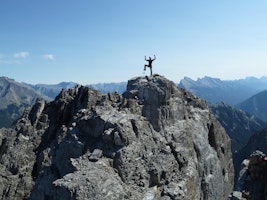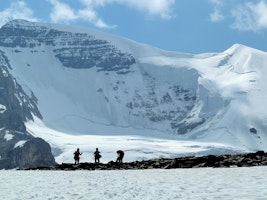Boasting more than 150 mountain peaks that reach at least 2,500 meters of elevation, Canada is a premier mountain climbing destination, especially for intermediate and advanced mountaineers.
The vast majority of these peaks are located in the western half of the country, in Alberta, British Columbia, Yukon, and the Northwest Territories. Although there are some peaks way up in the Qikiqtaaluk Region of northerly Nunavut as well.
With mountains stretching from Canada’s border with the United States all the way to the shores of the Arctic Ocean – more than 2,200 kilometers away – there are a plethora of different and challenging climbing options available, from two-day ascents up to three-week-long treks.
Regardless of where you head or how long you spend there, two things are nearly certain: you will find plenty of great challenges and even more incredible views to reward your efforts.
Whether you are in the remote reaches of Kluane National Park heading to Mount Logan or just outside of Vancouver on the slopes of Mount Garibaldi, the majestic beauty of snow-capped peaks, dense forests and blue mountain lakes will greet you at every turn.
Since you could spend an entire lifetime climbing mountains in Canada and still not get to all of them, we’ve composed a list of six of the best challenging mountain peaks to climb in the country. Enjoy and get to it!
1. Mount Logan
Canada’s highest peak and the second tallest mountain in North America sits in the remote wilderness of Kluane National Park, in southwest Yukon.

Conquering the highest alpine climb wall in all of North America. Photo courtesy of Canada Adventure Guides.
Undertaking an expedition to Mount Logan’s summit begins with a flight into the small little city of Haines Junction, before chartering a flight on to Mount Logan’s base camp. From base camp, you will spend the next three weeks trekking up and down the mountain, setting up camps and slowly acclimatizing.
There are several routes up to the summit of Mount Logan, some of which are slightly less technical and others that are certainly more challenging. The King Trench Route is the easiest and least technical one to the peak’s summit but is still quite a challenge. It involves progressively heading up through five different camps until reaching the summit.
The East Ridge is a more challenging option and involves what is widely considered to be the best high alpine wall climb in all of North America.
Regardless of the route you choose to climb, the scenery is extraordinary. There are few signs of human settlement anywhere, giving you the feeling of being at one with nature and the panoramic vista from the summit provides perhaps the best views of the Yukon Territory!
In brief:
Height: 5,595 meters
Location: Haines Junction, Yukon Territory
Duration of the ascent: 3 weeks
Difficulty level: Advanced
So don’t wait! Book your next mountain climbing adventure to the summit of Mount Logan right now!
2. Mount Waddington
Situated in the heart of the Pacific Range, midway up the province of British Columbia, Mount Waddington cuts an imposing figure over the horizon.
The peak is the highest that sits solely in British Columbia (two mountains that sit on the American border are slightly taller) and its ascent has been compared to that of Mont Blanc.

Incredible views of the remote Pacific Range backcountry await at every turn on the slopes of Mount Waddington. Photo courtesy of Brian Jones.
There are several routes up to the summit of Mount Waddington, but the northeast face is the easiest and most popularly taken. Climbing via the south face is also popular, but requires advanced-level rock and ice climbing skills to accomplish. Nearly all routes will require hiring a helicopter or seaplane to get to the start.
Part of the wonder of climbing the Wadd, as it is affectionately known in mountaineering circles, is the approach. Regardless of where you start, you’ll begin by hiking through lovely alpine scenery before climbing up one of the peaks’ various glaciers. From here, expect beautiful views out over the Coastal Range.
On the northeast face route, you will traverse the Bravo Glacier until you reach the Spearmen Col. From here, it is not an overly technical climb to the summit pyramid and then on to the summit.
In brief:
Height: 4,019 meters
Location: Tatla Lake, British Columbia
Duration of the ascent: 1 week
Difficulty level: Intermediate
Don’t hesitate! Book now for your next alpine adventure and climb Mount Waddington in the beautiful British Columbia backcountry!
3. Mount Robson
Sitting on the western flank of the Canadian Rocky Mountain, Mount Robson is the highest peak in the mountain range and the second tallest in British Columbia.

Known as one of the most challenging climbs in Canada, Mount Robson is also one of the most scenic. Photo courtesy of David Lussier.
It is also considered one of the most challenging climbs in Canada. The mountain is perfect for advanced mountaineers looking to challenge themselves and test their skills.
The Kain Face route, which follows the route taken during the first ascent of the peak, is the easiest and most popular one. It involves an incredibly scenic approach through high alpine meadows and thick evergreen forest before reaching the foot of the peak.
From here, climbers will ascend the Robson Glacier, before reaching Robson Pass and climbing along the northeast face to reach the summit. The climb is long and hard, but the incredible views from the top are more than reward enough for your efforts.
In brief:
Height: 3,954 meters
Location: Valemount, British Columbia
Duration of the ascent: 5 days
Difficulty level: Sustained
What are you waiting for? Book now for your next mountain climbing challenge in the Canadian Rockies!
4. Mount Athabasca north face
Situated within the Columbia ice field of Jasper National Park, Mount Athabasca is perhaps the third most well-known in the Canadian Rockies after Mount Robson and Temple Mountain.

Enjoy the fairly easy, but quite exposed, ice climbing en route to the summit. Photo courtesy of Jeff Bullock.
The peak’s north face offers some classic alpine climbing that is easily done by intermediate-level participants. The majority of the ascent is Class III (5.8) ice climbing that is not very technically challenging but is quite exposed.
Ascending the peak involves trekking across a glacial cirque before beginning the actual climbing. From here, you will mainly find a mix of rock and ice climbing before reaching the summit ridge and heading along it to the summit proper.
The climb is generally done in two days, hiking to a base camp on the first day before getting an alpine start (2 or 3 am) and making your way up to the summit before noon. One of the highlights of the trips is enjoying the stunning sunrise over the ice field. There are few views quite like it.
In brief:
Height: 3,491 meters
Location: Athabasca Falls, Alberta
Duration of the ascent: 2 days
Difficulty level: Intermediate
Wait no longer! Make your next mountaineering adventure an ascent of Mount Athabasca’s north face today!
5. Mount Garibaldi
Sitting just 80 kilometers north of Vancouver, Mount Garibaldi is one of the most well-known peaks in British Columbia and a popular weekend climbing destination for residents of the city.

Trekking across a glacier to reach Mount Garibaldi’s summit. Photo courtesy of Brian Jones.
The potentially active stratovolcano dominates the skyline of southern British Columbia’s Coast Mountains and presents an excellent challenge for upper-intermediate level climbers.
Ascending via the east face and north face are the two most popular routes. These both begin with an incredibly scenic hike through alpine meadows and evergreen forests before arriving at the Garibaldi Neve ice field.
From here, climbers will traverse the glacier, using a mix of glacier hiking and ice climbing to get to the top of the ice field and begin ascending to the summit. Views of the surrounding landscape are incredible and well worth the effort required to get there.
The peak is best climbed outside of the summer months due to the numerous crevasses that are revealed once the ice begins to melt.
In brief:
Height: 2,678 meters
Location: Squamish, British Columbia
Duration of the ascent: 2 days
Difficulty level: Sustained
Spend your weekend in Vancouver doing something incredible. Book a trip to the top of Mount Garibaldi!
6. Mount Victoria
Sitting on the border of Yoho and Banff National Parks, where Alberta and British Columbia meet, Mount Victoria is among the most classic of Canadian alpine expeditions.

Sitting in the heart of the Canadian Rockies, Mount Victoria is perhaps the most classic alpine climb in all of Canada. Photo courtesy of Jeff Bullock.
The climb begins with a one-day hiking approach from Lake O’Hara, which offers plenty of incredible views of the rugged mountain and alpine forest scenery. The day finishes up with a scrambling ascent to the historic Abbot Pass refuge cabin over some loose scree.
The following day, you will head west from the refuge and along some rough trails until you reach the actual ridge. Here, you will need to put on the crampons and climb over a mix of rock and ice until reaching a feature called the ‘sickle’.
Once you’ve reached the sickle, there’s just a bit more climbing until reaching the summit, which yields incredible views out over the rest of the Canadian Rockies.
After descending from the summit and reaching the Abbot Pass refuge once again, many climbers opt to spend an additional day climbing Mount Lefroy (3,423 meters) and/or Mount Huber (3,370 meters).
In brief:
Height: 3,464 meters
Location: Lake Louise, Alberta
Duration of the ascent: 2-3 days
Difficulty level: Intermediate
Don’t hesitate! Book your next mountaineering adventure to the summit of mighty Mount Victoria right now!
If you’ve taken a look at this list and are feeling the call of the wild, but don’t think you have the skills to answer it, then we recommend taking a mountaineering course in Canada to get you on your way to summiting one of these incredible mountains.
You can also check out all the options for mountain climbing in Canada with a certified guide and pick your next challenge!







